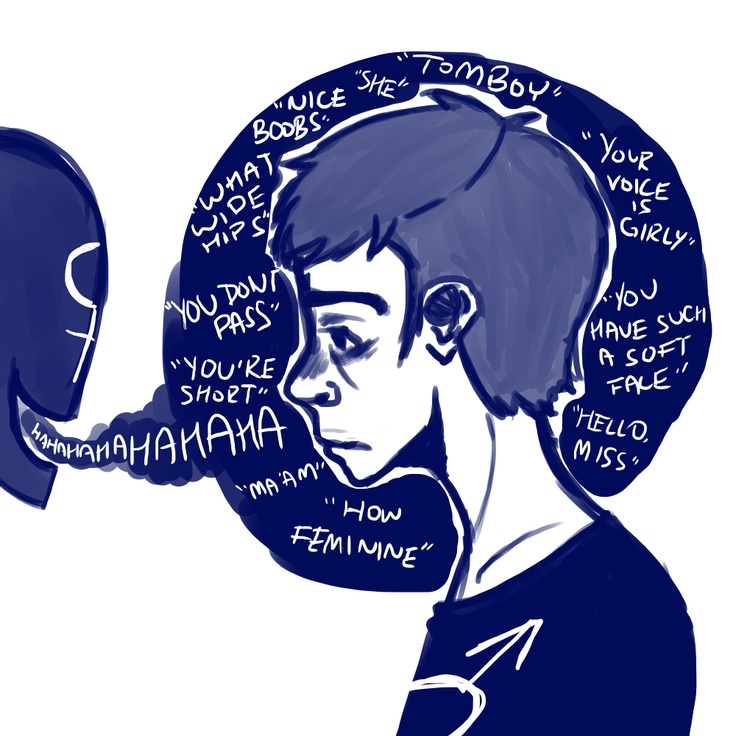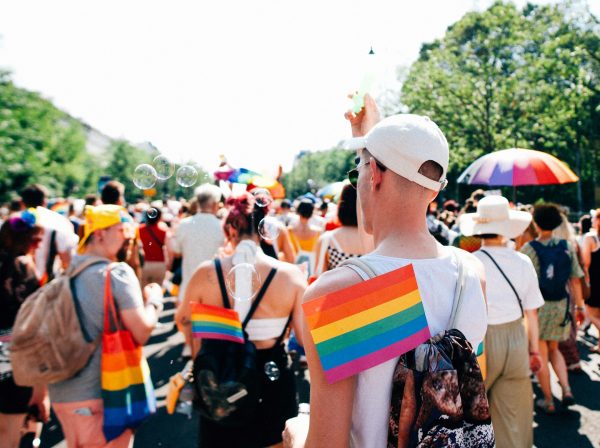Dysphoria is a deep down feeling about yourself or your body that many (but not all) trans* people feel. Trans*-ness is sometimes described as being born in the wrong body. The reality is that if a woman happens to have a penis it is a woman’s penis, or if a trans man has a uterus it is a man’s uterus, or a non-binary person has a non-binary body. It’s not always that easy. It’s harder to maintain that belief or apply it to oneself when dysphoria sets in.
Bodies are seen mostly as something that is inherently sexed because that has been the rhetoric for so long. Despite our bodies being ours, living in a culture that tells me my body is “biologically female,” tells my friend she is “biologically male,” tells my friend he “can’t be a man if his body is a woman’s,” and so on, it’s a tall order not to internalize. Despite transgressing a/genders, we still have or have had similar experiences. Internalization. When one internalizes dominant rhetoric, it’s not easy to unpack.
Webster-Collins defines it as “a state of dissatisfaction, anxiety, restlessness, or fidgeting.” But the experience of dysphoria also goes way deeper than that. There are three broad categories of dysphoria—Body Dysphoria, Mental Dysphoria, and Social Dysphoria. Like many feelings or emotions, they’re truly difficult to verbalize, especially because not all trans people feel it. Those who do go certainly don’t all feel it in the same way.
Bodily Dysphoria is something I do not experience (often), so I cannot talk comprehensively on the vast, unique, and sometimes painful ways it manifests. Outwardly, signs are anxiety and frustration, dissociation, and sometimes tears; I cannot begin to describe how it feels on the inside.
Mental dysphoria, an extreme, inescapable feeling of cognitive dissonance, is something I personally experience every day. Feeling masculine—being masculine—while knowing I will most likely be perceived as a woman. It’s the mind writhing against the gender confines one is “supposed” to be in while still feeling like you’re trapped by them. Racing, invasive thoughts like “why couldn’t I just have been the gender I was assigned at birth? It would be so much easier!” Yet trying to conform to that is also torturous and triggering, because in this case, one is not what they were assigned at birth. Simultaneously, I think this while I know that my masculinity is valid, who I am, and wanting to express it. So, it’s kind of like a tug-of-war between these two categories of fractured thoughts. And it just won’t go away. Dysphoria in general, including Mental Dysphoria, isn’t always present; some days are worse than others, some days it’s not there at all.
Social Dysphoria manifests mostly in social situations. Being misgendered (accidentally or otherwise) can trigger Social Dysphoria, or just simple day-to-day interactions other people may perceive as logical or normal, such as a baby shower invite with the pink script while your guy friend receives a wedding invite with a blue script. When I say, or someone says for me, “JayJay identifies as ____,” it’s disheartening. I am “_____,” so why do we have to say I identify as? Of course, I do! Because I am. While masculinity and femininity belong to no gender exclusively, social situations often unconsciously have gender roles weaved into them. It creates severe anxiety, and for me often results in choosing not to go out due to fear of social situations and in turn Social Dysphoria.
Not all trans* people experience dysphoria. Some trans* people experience certain kinds while not experiencing other kinds. A lot of the time it’s a mix of the two; a lot of the time, it can be none. It’s important not to homogenize trans* people—or anyone! A trans* person who doesn’t experience dysphoria is not “not trans enough,” they are not “a [insert gender] in denial,” and if they don’t fit expectations of what trans/Queer “should” be, that doesn’t give anyone a right to question their a/gender.





